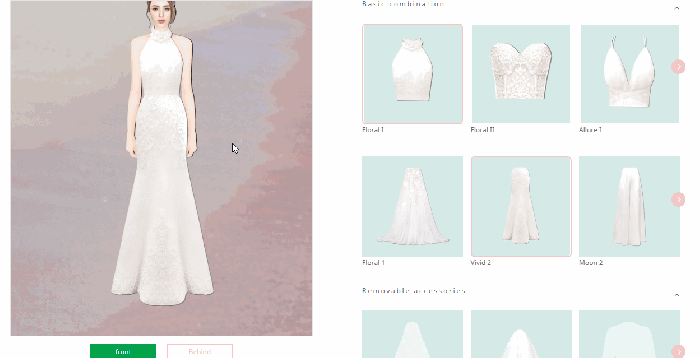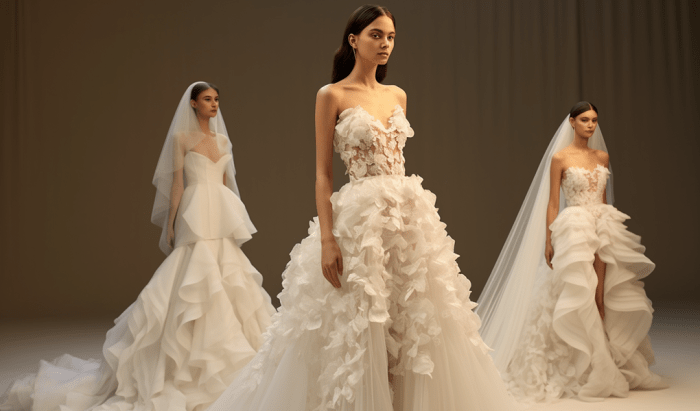Customizing Your Dream Wedding Dress: Customize A Wedding Dress
Customize a wedding dress – Choosing a wedding dress is a momentous occasion, and many brides desire a gown that perfectly reflects their unique style and personality. Customizing a wedding dress offers the opportunity to create a truly one-of-a-kind masterpiece, tailored to your body, preferences, and vision. This guide explores the various aspects of customizing a wedding dress, from understanding the options available to budgeting and timeline considerations.
Customization Options: From Alterations to Bespoke Designs
The spectrum of customization options is vast, ranging from minor adjustments to complete redesigns. Off-the-rack alterations involve modifying a pre-existing dress to fit your body and preferences. This might include adjusting the length, altering the neckline, or adding sleeves. Bespoke dress creation, on the other hand, starts from scratch, allowing for complete control over every detail, from fabric selection to embellishments.
Common customization choices include neckline styles (e.g., sweetheart, V-neck, halter), sleeve lengths (e.g., sleeveless, short sleeves, long sleeves), train length (e.g., chapel train, cathedral train, sweep train), fabric selection (e.g., lace, silk, satin, tulle), and embellishments (e.g., beading, embroidery, appliqués).
| Customization Level | Description | Approximate Cost | Approximate Timeline |
|---|---|---|---|
| Minor Alterations | Hemming, minor adjustments to fit | $100 – $300 | 1-2 weeks |
| Moderate Alterations | Significant adjustments to neckline, sleeves, or train | $300 – $800 | 3-6 weeks |
| Extensive Alterations | Major structural changes, adding or removing significant elements | $800 – $1500 | 6-8 weeks |
| Bespoke Design | Creating a dress from scratch | $1500+ | 4-6 months |
Fabric Selection and its Influence, Customize a wedding dress
Fabric choice significantly impacts the overall look, feel, and cost of a customized wedding dress. Each fabric possesses unique properties in terms of drape, durability, and cost. Lace offers intricate detailing and romantic aesthetics, while silk provides a luxurious and elegant drape. Satin offers a sleek and sophisticated look, and tulle is often used for creating volume and texture.
| Fabric | Pros | Cons | Suitable Customization Options |
|---|---|---|---|
| Lace | Intricate detailing, romantic look | Can be delicate, may require careful handling | Intricate detailing, appliqués, beading |
| Silk | Luxurious drape, elegant feel | Can be expensive, requires professional cleaning | Clean lines, simple silhouettes, embellishments |
| Satin | Sleek, sophisticated look, easy to clean | Can show wrinkles easily, less breathable | Sleek silhouettes, beading, minimal embellishments |
| Tulle | Creates volume, soft texture | Can be easily damaged, needs careful handling | Layers, volume, romantic styles |
Embellishments and Design Elements: Enhancing Your Dress

Source: brihaspatitech.com
Embellishments add personality and visual interest to a wedding dress. Beading, embroidery, appliqués, and sequins are just a few options available. The choice of embellishment significantly influences the overall style and aesthetic of the dress. For instance, delicate beading creates a refined look, while bold embroidery adds a touch of drama.
- Bohemian Style: Lace appliqués, floral embroidery, delicate beading
- Classic Style: Clean lines, minimal embellishments, subtle beading
- Modern Style: Geometric patterns, bold embellishments, metallic accents
The Design Process: From Initial Concept to Final Fitting
Designing and customizing a wedding dress is a collaborative process involving several key steps. It begins with an initial consultation to discuss the bride’s vision, style preferences, and body measurements. The designer or seamstress then creates sketches and fabric samples to visualize the design. Multiple fittings are conducted to ensure a perfect fit and to incorporate any necessary adjustments.
Customizing your wedding dress allows for unparalleled personal expression. If you’re drawn to elegant necklines, consider a sophisticated cowl neck design; for inspiration, check out the stunning options available at this link: cowl neck dress wedding. Ultimately, the goal is to create a gown that perfectly reflects your unique style and personality, so explore various details to achieve your vision.
The process culminates in the final fitting, where the dress is completed and ready for the big day.
The designer or seamstress plays a crucial role in guiding the bride through the process, offering expert advice on design choices, fabric selection, and embellishments. Effective communication and collaboration between the client and the designer are essential for achieving the desired outcome. Each fitting allows for refinements and adjustments, ensuring the dress perfectly complements the bride’s body and style.
Budgeting and Timeline: Planning Your Customization

Source: inweddingdress.com
The cost of customizing a wedding dress depends on several factors, including fabric selection, embellishments, and the level of customization. Bespoke designs naturally command a higher price than simple alterations. It’s essential to create a realistic budget and timeline that accounts for design, alterations, and potential delays. Consider setting aside a contingency budget to accommodate unexpected expenses.
For example, a simple alteration might cost between $100 and $300, while a bespoke design could range from $1500 to several thousand dollars, depending on the complexity and materials used. A realistic timeline for a bespoke dress is typically 4-6 months, allowing ample time for design, fabric sourcing, construction, and fittings. For alterations, the timeline is generally shorter, ranging from a few weeks to a couple of months, depending on the complexity of the changes.
Helpful Answers
What is the average cost of customizing a wedding dress?
The cost varies greatly depending on the level of customization, fabric choices, and embellishments. Expect a wide range, from a few hundred dollars for minor alterations to several thousand for a completely bespoke gown.
How much time should I allow for customizing my wedding dress?
Allow at least six months, ideally longer, to account for design, fittings, and potential delays. Complex designs or intricate embellishments will require more time.
Can I customize a pre-existing dress I already own?
Yes, many alterations and customization options are available for existing dresses. A skilled seamstress can help you achieve your desired look.
What if I’m unsure of my design preferences?
Consult with a wedding dress designer or stylist. They can help you explore different styles and find the perfect design to suit your body type and personal style.
